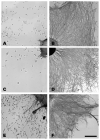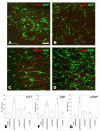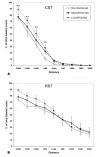Transduced Schwann cells promote axon growth and myelination after spinal cord injury
- PMID: 17719577
- PMCID: PMC3513343
- DOI: 10.1016/j.expneurol.2007.06.023
Transduced Schwann cells promote axon growth and myelination after spinal cord injury
Abstract
We sought to directly compare growth and myelination of local and supraspinal axons by implanting into the injured spinal cord Schwann cells (SCs) transduced ex vivo with adenoviral (AdV) or lentiviral (LV) vectors encoding a bifunctional neurotrophin molecule (D15A). D15A mimics actions of both neurotrophin-3 and brain-derived neurotrophic factor. Transduced SCs were injected into the injury center 1 week after a moderate thoracic (T8) adult rat spinal cord contusion. D15A expression and bioactivity in vitro; D15A levels in vivo; and graft volume, SC number, implant axon number and cortico-, reticulo-, raphe-, coerulo-spinal and sensory axon growth were determined for both types of vectors employed to transduce SCs. ELISAs revealed that D15A-secreting SC implants contained significantly higher levels of neurotrophin than non-transduced SC and AdV/GFP and LV/GFP SC controls early after implantation. At 6 weeks post-implantation, D15A-secreting SC grafts exhibited 5-fold increases in graft volume, SC number and myelinated axon counts and a 3-fold increase in myelinated to unmyelinated (ensheathed) axon ratios. The total number of axons within grafts of LV/GFP/D15A SCs was estimated to be over 70,000. Also 5-HT, DbetaH, and CGRP axon length was increased up to 5-fold within D15A grafts. In sum, despite qualitative differences using the two vectors, increased neurotrophin secretion by the implanted D15A SCs led to the presence of a significantly increased number of axons in the contusion site. These results demonstrate the therapeutic potential for utilizing neurotrophin-transduced SCs to repair the injured spinal cord.
Figures






Similar articles
-
Combining neurotrophin-transduced schwann cells and rolipram to promote functional recovery from subacute spinal cord injury.Cell Transplant. 2013;22(12):2203-17. doi: 10.3727/096368912X658872. Epub 2012 Nov 8. Cell Transplant. 2013. PMID: 23146351
-
Combination of engineered Schwann cell grafts to secrete neurotrophin and chondroitinase promotes axonal regeneration and locomotion after spinal cord injury.J Neurosci. 2014 Jan 29;34(5):1838-55. doi: 10.1523/JNEUROSCI.2661-13.2014. J Neurosci. 2014. PMID: 24478364 Free PMC article.
-
Poly (D,L-lactic acid) macroporous guidance scaffolds seeded with Schwann cells genetically modified to secrete a bi-functional neurotrophin implanted in the completely transected adult rat thoracic spinal cord.Biomaterials. 2006 Jan;27(3):430-42. doi: 10.1016/j.biomaterials.2005.07.014. Epub 2005 Aug 18. Biomaterials. 2006. PMID: 16102815
-
Realizing the maximum potential of Schwann cells to promote recovery from spinal cord injury.Handb Clin Neurol. 2012;109:523-40. doi: 10.1016/B978-0-444-52137-8.00032-2. Handb Clin Neurol. 2012. PMID: 23098734 Review.
-
Schwann cell transplantation: a repair strategy for spinal cord injury?Prog Brain Res. 2012;201:295-312. doi: 10.1016/B978-0-444-59544-7.00014-7. Prog Brain Res. 2012. PMID: 23186720 Review.
Cited by
-
The potential for cellular therapy combined with growth factors in spinal cord injury.Stem Cells Int. 2012;2012:826754. doi: 10.1155/2012/826754. Epub 2012 Oct 3. Stem Cells Int. 2012. PMID: 23091499 Free PMC article.
-
Decellularized peripheral nerve supports Schwann cell transplants and axon growth following spinal cord injury.Biomaterials. 2018 Sep;177:176-185. doi: 10.1016/j.biomaterials.2018.05.049. Epub 2018 May 28. Biomaterials. 2018. PMID: 29929081 Free PMC article.
-
Secretion of a mammalian chondroitinase ABC aids glial integration at PNS/CNS boundaries.Sci Rep. 2020 Jul 9;10(1):11262. doi: 10.1038/s41598-020-67526-0. Sci Rep. 2020. PMID: 32647242 Free PMC article.
-
Hypoxia-Inducible Factor 1α (HIF-1α) Counteracts the Acute Death of Cells Transplanted into the Injured Spinal Cord.eNeuro. 2020 May 11;7(3):ENEURO.0092-19.2019. doi: 10.1523/ENEURO.0092-19.2019. Print 2020 May/Jun. eNeuro. 2020. PMID: 31488552 Free PMC article.
-
Biphasic bisperoxovanadium administration and Schwann cell transplantation for repair after cervical contusive spinal cord injury.Exp Neurol. 2015 Feb;264:163-72. doi: 10.1016/j.expneurol.2014.12.002. Epub 2014 Dec 12. Exp Neurol. 2015. PMID: 25510318 Free PMC article.
References
-
- Bahr M, Hopkins JM, Bunge RP. In vitro myelination of regenerating adult rat retinal ganglion cell axons by Schwann cells. Glia. 1991;4:529–533. - PubMed
-
- Bamber NI, Li H, Lu X, Oudega M, Aebischer P, Xu XM. Neurotrophins BDNF and NT-3 promote axonal re-entry into the distal host spinal cord through Schwann cell-seeded mini-channels. Eur. J. Neurosci. 2001;13:257–268. - PubMed
-
- Basso DM, Beattie MS, Bresnahan JC. A sensitive and reliable locomotor rating scale for open field testing in rats. J. Neurotrauma. 1995;12:1–21. - PubMed
Publication types
MeSH terms
Substances
Grants and funding
LinkOut - more resources
Full Text Sources
Medical
Research Materials

